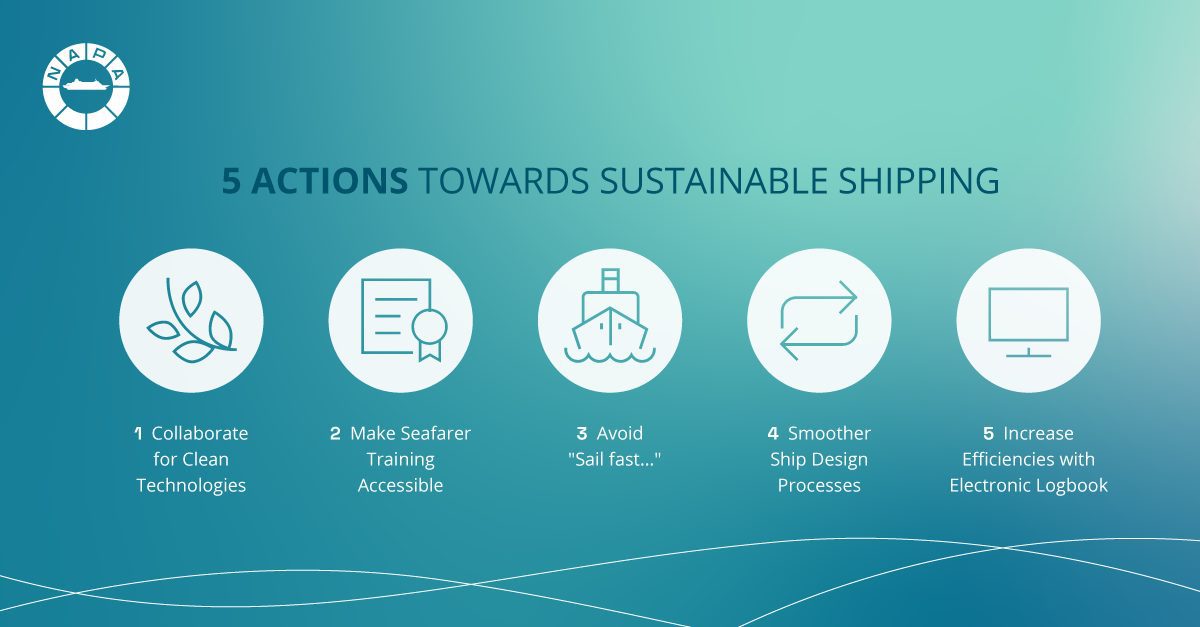November 30, 2023
Five actions towards sustainable shipping that marked 2023

With MEPC 80, CII taking effect, and the official extension of EU ETS to shipping, 2023 was the year when the conversation on decarbonization moved from concept to implementation. This shift was brought to life by industry pioneers who rose to the challenge on several fronts, from clean technology to digitalization and training. Here are five ways in which NAPA has helped them shape a greener future for shipping this year.
2023 will undoubtedly go down in maritime history books for the landmark adoption of a net-zero target for the middle of this century by the IMO. But equally important for shipping’s decarbonization trajectory was the shift in mindsets that accompanied this regulatory development: shipping is now recognizing the need for immediate actions with a tangible impact on greenhouse gas (GHG) emissions from the maritime sector.
And action is indeed happening, thanks to trailblazer shipowners, operators, shipyards and technology providers. Their successes this year show that the road to net-zero will be made of incremental, but concrete steps – making the most of available technology in a way that is rooted in facts and evidence. This is where NAPA’s expertise in maritime software and data analysis can be a valuable ally for the industry – here are five concrete examples where we put it in action in 2023.
Action 1: Collaborate to quantify and validate the impact of clean technologies
In February, together with shipowner Marubeni and classification society ClassNK, we announced the results of a joint study which measured the impact of voyage optimization on the greenhouse gas emissions and Carbon Intensity Indicator (CII) ratings of a real-life fleet. The research found that voyage optimization enables ships to reduce their fuel consumption and CO2 emissions by up to 7.3%, and maintain their CII ratings for an additional two to three years.
In another partnership, the results of our joint simulation project with wind propulsion systems provider Norsepower, and world-leading shipyard Sumitomo Heavy Industries were unveiled in May. The study measured the emissions reductions potential of combining rotor sails and voyage optimization, finding up to 28% savings on the Atlantic route between New York and Amsterdam.
Studies like these are essential, because they help build a concrete business case for energy efficiency and clean technology. Validated data on the actual fuel and emissions reductions delivered is critical to give shipowners certainty on the performance of these systems in real life, helping inform strategic and investment decisions. They are also tangible examples of NAPA’s broader commitment to help expand collective knowledge in the maritime sector and beyond. This year, we continued to collaborate with research institutions, academia, and cross-industry projects such as VesselAI and the Clean Propulsion Technologies Consortium to help bridge some of the current knowledge gaps and enable the industry to progress with confidence.
Action 2: Training seafarers to ensure safety in a fast-evolving technology landscape
2023 has marked the beginning of NAPA’s partnership with maritime training providers Simwave and the Maritime Skills Academy to make critical stability training more accessible, flexible, and convenient for seafarers – both in person and remotely.
This is in line with NAPA’s long-term commitment to collaborate with various maritime training institutions and shipping companies themselves (including the Royal Caribbean Group and Carnival Corporation’s CSMART) to deliver training that is essential to ensure safety at sea to a greater number of crew.
This is becoming more important than ever in the context of shipping’s decarbonization journey. The transition will require the fast-paced adoption of new technologies on board, from digital platforms to new propulsion systems and, ultimately, alternative fuels – all of which present their own safety challenges. Training partnerships help address the industry’s training and upskilling challenge, equipping seafarers with the knowledge and hands-on experience needed to ensure safe and efficient operations as new fuels and technologies are introduced.
Action 3: Tackling “Sail Fast Then Wait” with a trusted collaborative platform
Blue Visby, a cross-industry initiative aimed at tackling “sail fast then wait”, has this year welcomed a first financial institution in its ranks, with the Development Bank of Japan joining the Consortium, helping demonstrate the financial credibility of the project. This is part of a fast-growing wave of support for Blue Visby, with the number of participating companies rising from the 13 founding members to 32 at the end of 2023.
The Blue Visby platform, which is supported by NAPA’s digital expertise, staggers and optimizes arrivals for groups of vessels travelling to a port, which enables ships to slow down and reduce their emissions by 15% on average without losing a competitive advantage. Following successful virtual pilots, the next step will be the development of real-life prototypes to make the solution available for different shipping segments.
The success of Blue Visby, both on the collaboration and technical fronts, shows that it is possible to collaborate to remove one of the biggest obstacles that stands in the way of shipping’s decarbonization, and do so in a way that makes business sense for everyone involved.
Action 4: Streamlining ship design processes to enable innovation
In January, Damen Engineering announced the completion of their very first vessel design to be entirely created, reviewed and class-approved using 3D models, in collaboration with NAPA and classification society Bureau Veritas (BV). This year then saw a growing uptake of 3D model-based approvals (3D MBA), a process in which class societies review and approve designs using 3D models rather than 2D drawings, the current norm. For example, Damen and DNV are also using NAPA’s tools to streamline classification involvement in the early design phases, while joint projects with Hanwha and SDARI have validated the benefits of 3D MBA.
This is important because 3D model-based approvals help make the design process more streamlined, efficient, and collaborative. This is essential to enable naval architects and engineers to innovate at pace and create the next generation of greener, energy efficient vessels that are demanded by the industry – while also enhancing their own productivity to ensure strong, profitable businesses. In short, 3D MBA is building the foundation for ship design innovation.
Action 5: Empowering companies with electronic logbooks to measure, report and improve sustainability
Finally, NAPA is empowering companies to make the most of their onboard data with a tool whose potential is often unrealized: electronic logbooks. A great example is our agreement with Finnlines to deploy our NAPA Logbook on newbuild electric ferries, which will not only automate and streamline reporting, but also harness this goldmine of verified data to generate insights that will help minimize emissions and ensure the safety of ferry operations between Finland and Sweden.
NAPA Logbook is already in use by more than 40 companies in the cruise and ferry sector, including industry leaders like Royal Caribbean International, Carnival Cruise Line, Virgin Voyages, Holland America Group, and Norwegian Cruise Line. Most recently, gas shipping company Anthony Veder became one of the first companies in the merchant shipping segment to deploy NAPA Logbook as their official logbook. The long-term ambition is to leverage log and voyage data to enhance the safety, efficiency and sustainability of operations across its fleet.
The ability to capture and integrate data is essential to benchmark, analyze and improve any aspect of operations – from a company’s carbon footprint to food and water waste, recycling and single-use plastics usage, safety practices and seafarer workloads. This will become increasingly important to achieve sustainable operations in a broader sense, as pressure will come from an ever-broadening set of stakeholders – the EU under its Corporate Sustainability Reporting Directive (CSDR), but also investors, financiers, and their end customers demanding ESG data under Scope 3 requirements.
What next?
As 2023 comes to a close, there is reason for optimism. These industry-led initiatives show that taking tangible steps towards decarbonization today is not only possible, but can make sense for operations, businesses and bottom lines.
They are also a reminder that decarbonizing shipping is a multi-faceted endeavor. To succeed, optimizing voyages, harnessing wind power, developing new engines and vessels, and training crews, must all happen at once. Action is needed on all fronts, and shipping’s silent heroes are making strides on multiple fronts, too.
This is encouraging news as 2024 heralds yet another phase of shipping’s decarbonization, with companies having to find their feet under the EU ETS era and receiving their first ratings under the IMO’s Carbon Intensity Indicator (CII) regulation. But this year has shown that the industry can, and is willing to, collaborate in the decarbonization journey. Surely and steadily, it is on those concrete actions that shipping’s net-zero future will be built.
